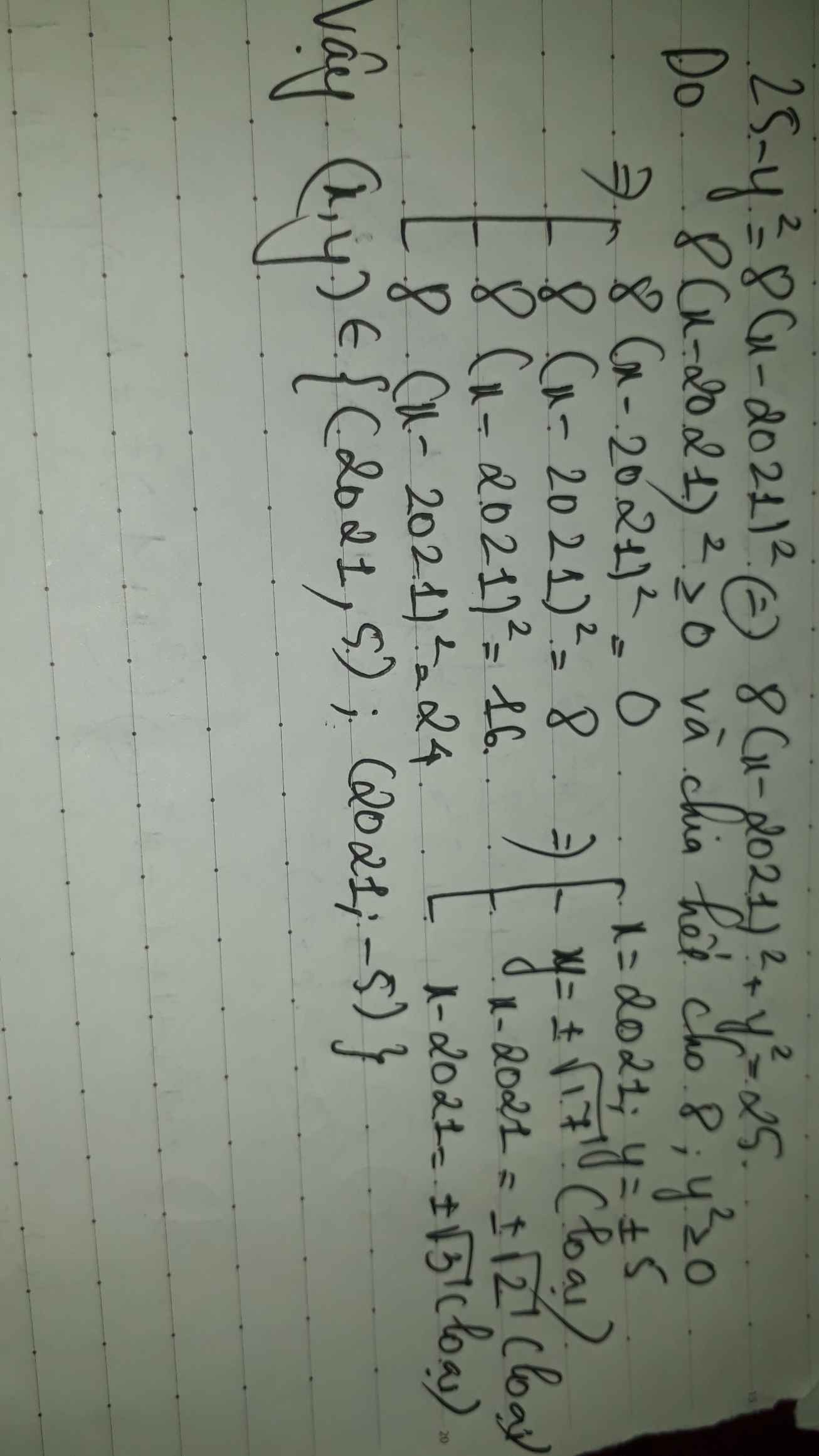
Hãy nhập câu hỏi của bạn vào đây, nếu là tài khoản VIP, bạn sẽ được ưu tiên trả lời.


Dễ thấy rằng: 8(x-100)^2 chia hết cho 8
=> y^2 chia 8 dư 1
=> y E {1;3;5} (vì y^2 =< 25)
+) y=1 khi đó: 24=8(x-100)^2
=> 3=(x-100)^2 (3 không là số chính phương) (loại)
+) y=3 khí đó: 25-y^2=16=>(x-100)^2=2
2 không là số chính phương (loại)
+) y=5=> (x-100)^2=0
=> x=100 (thỏa mãn)
Vậy: y=5;x=100

Vì (x-100)2 \(\ge\) 0 => 8 (x-100 ) 2 \(\ge\) 0
=> 25 - y2 \(\ge\) 0
=> y2 \(\le\) 25 mà y là số chính phương => y \(\in\) {1;2;3;4;5}
Mà 25 - y2 \(⋮\) 8 => y \(\in\) {1;3;5}
TH1 y=1
8(x-100 ) 2 = 24
(x-100)2 = 3 (loại )
TH2 y=3
8(x-100) 2 = 16
(x-100 ) 2 = 2 (loại )
TH3 y=5
8(x-100)2 = 0
(x-100 ) 2 = 0
(x-100 ) 2 = 02
=> x-100 = 0
=> x=100
Vậy \(\hept{\begin{cases}y=5\\x=100\end{cases}}\)


Ta có: 8.(x-2013)2+y2=25
=>y2=25-8.(x-2013)2
Vì \(\left(x-2013\right)^2\ge0=>8.\left(x-2013\right)^2\ge0=>25-8.\left(x-2013\right)^2\le25-0\)
=>\(y^2\le25=>y\le5\)
=>\(y\in\left\{1,2,3,4,5\right\}=>y^2\in\left\{1,4,9,16,25\right\}\)
Vì 25:8 dư 1, 8.(x-2013)2 chia 8 dư 0
=>25-8.(x-2013)2 chia 8 dư 1
=>y2 chia 8 dư 1
mà \(y^2\in\left\{1,4,9,16,25\right\}\)
=>y2=25=>y=5
25-8.(x-2013)2=25
=>8.(x-2013)2=0
=>(x-2013)2=0
=>x-2013=0
=>x=2013
Vậy x=2013, y=5

\(VT\ge0\Rightarrow\)\(-5\le y\le5\)
\(VT=8k^2\Rightarrow25-y^2=8k^2\Rightarrow k^2\le3\)
\(k^2=\left\{0,1\right\}\)
\(k=0\Rightarrow\hept{\begin{cases}x=2009\\y=+-5\end{cases}}\)
\(k^2=1\Rightarrow y^2=17\left(loai\right)\)
KL
\(\left(x,y\right)=\left(2009,-5\right);\left(2009,5\right)\)

Điều kiện đã cho \(\Leftrightarrow7\left(x-2019\right)^2+y^2=23\) (*)
Do \(\left(x-2019\right)^2,y^2\ge0\) nên (*) suy ra \(y^2\le23\Leftrightarrow y^2\in\left\{0,1,4,9,16\right\}\)
\(\Leftrightarrow y\in\left\{0,1,2,3,4\right\}\)
Hơn nữa, lại có \(y^2=23-7\left(x-2019\right)^2\). Ta thấy \(VP\) chia 7 dư 2.
\(\Rightarrow y^2\) chia 7 dư 2 \(\Rightarrow y\in\left\{3,4\right\}\)
Xét \(y=3\) \(\Rightarrow7\left(x-2019\right)^2=14\) \(\Leftrightarrow\left(x-2019\right)^2=2\), vô lí.
Xét \(y=4\Rightarrow7\left(x-2019\right)^2=7\) \(\Leftrightarrow\left(x-2019\right)^2=1\) \(\Leftrightarrow\left[{}\begin{matrix}x=2020\\x=2018\end{matrix}\right.\)
Vậy \(\left(x,y\right)\in\left\{\left(4;2020\right),\left(4;2018\right)\right\}\) thỏa mãn ycbt.

a: \(\left(2x-y+7\right)^{2022}>=0\forall x,y\)
\(\left|x-1\right|^{2023}>=0\forall x\)
=>\(\left(2x-y+7\right)^{2022}+\left|x-1\right|^{2023}>=0\forall x,y\)
mà \(\left(2x-y+7\right)^{2022}+\left|x-1\right|^{2023}< =0\forall x,y\)
nên \(\left(2x-y+7\right)^{2022}+\left|x-1\right|^{2023}=0\)
=>\(\left\{{}\begin{matrix}2x-y+7=0\\x-1=0\end{matrix}\right.\Leftrightarrow\left\{{}\begin{matrix}x=1\\y=2x+7=9\end{matrix}\right.\)
\(P=x^{2023}+\left(y-10\right)^{2023}\)
\(=1^{2023}+\left(9-10\right)^{2023}\)
=1-1
=0
c: \(\left|x-3\right|>=0\forall x\)
=>\(\left|x-3\right|+2>=2\forall x\)
=>\(\left(\left|x-3\right|+2\right)^2>=4\forall x\)
mà \(\left|y+3\right|>=0\forall y\)
nên \(\left(\left|x-3\right|+2\right)^2+\left|y+3\right|>=4\forall x,y\)
=>\(P=\left(\left|x-3\right|+2\right)^2+\left|y-3\right|+2019>=4+2019=2023\forall x,y\)
Dấu '=' xảy ra khi x-3=0 và y-3=0
=>x=3 và y=3

Ta có:
\(25-y^2=8\left(x-100\right)^2\)
Do VP là số chẵn nên VT là số chẵn
Suy ra y2là số lẻ nhỏ hơn hoặc bằng 25
\(\Rightarrow y^2\in\left\{25,16,9,4,1\right\}\)
\(\Rightarrow y\in\left\{5,4,3,2,1\right\}\)
Với y=5=>8(x-100)2=0
=>x=100
Với x=4=>8(x-100)2=9
=>không tồn tại số tự nhiên x
....(như bài mẫu trên)...
Vậy.......
vp và vt là j vậy bn